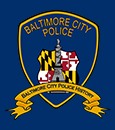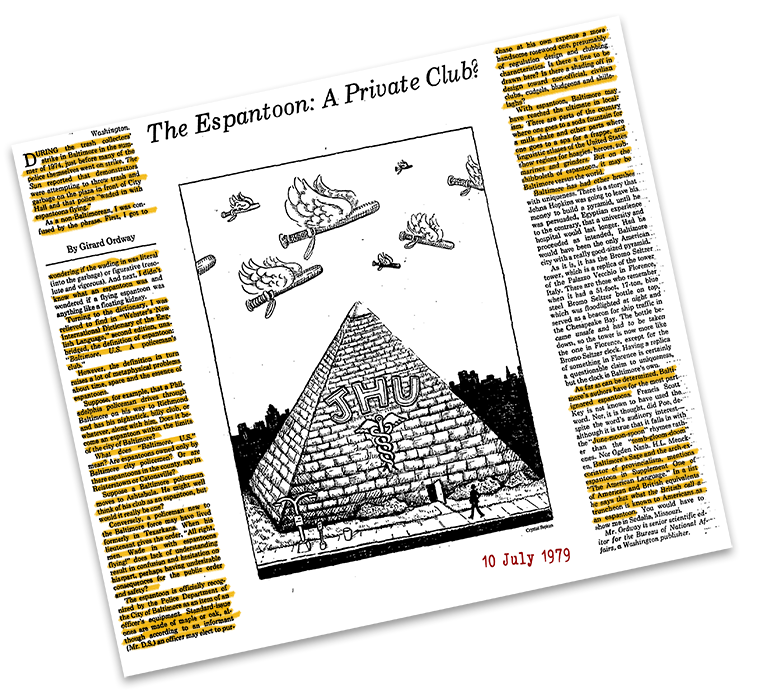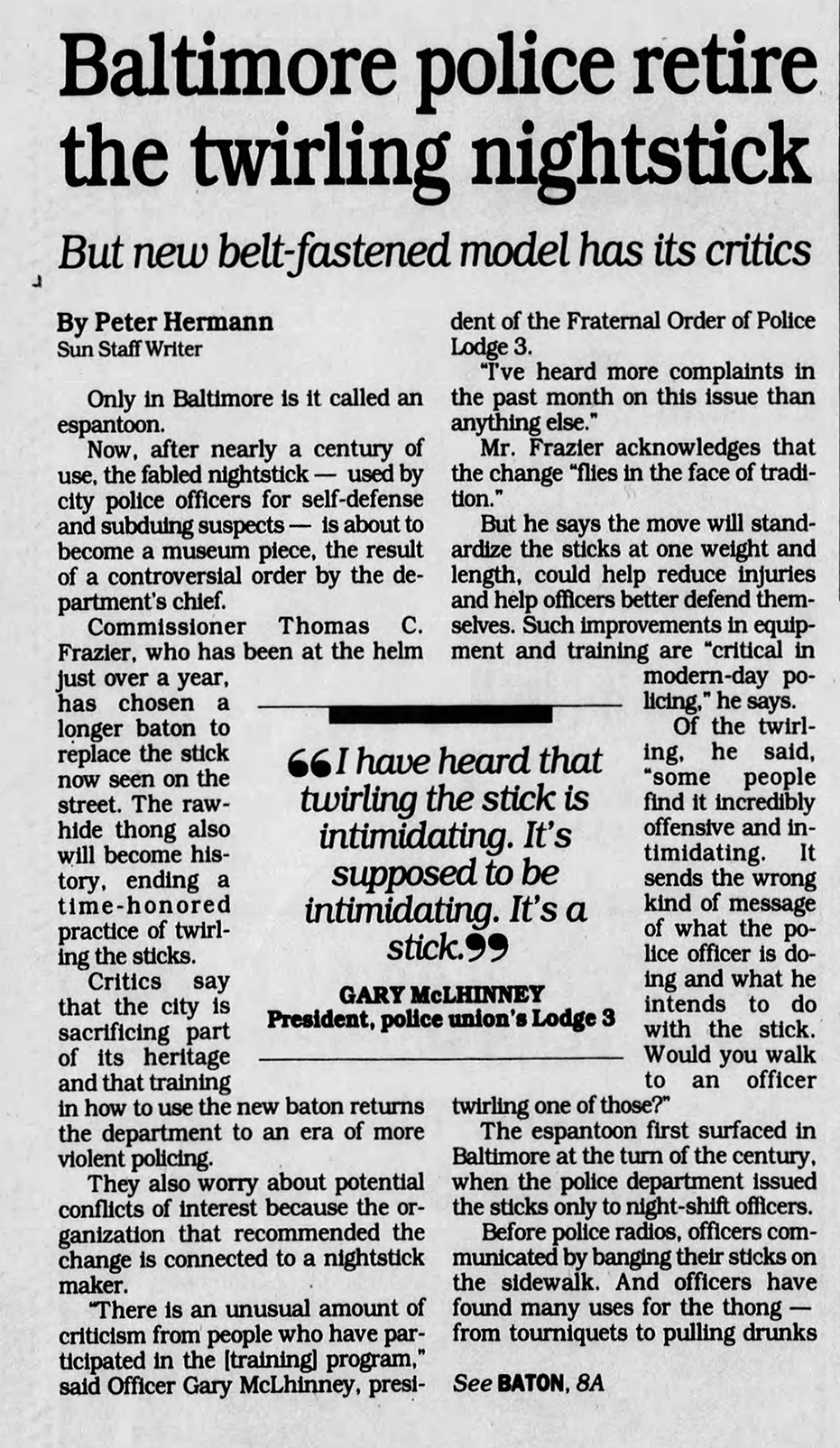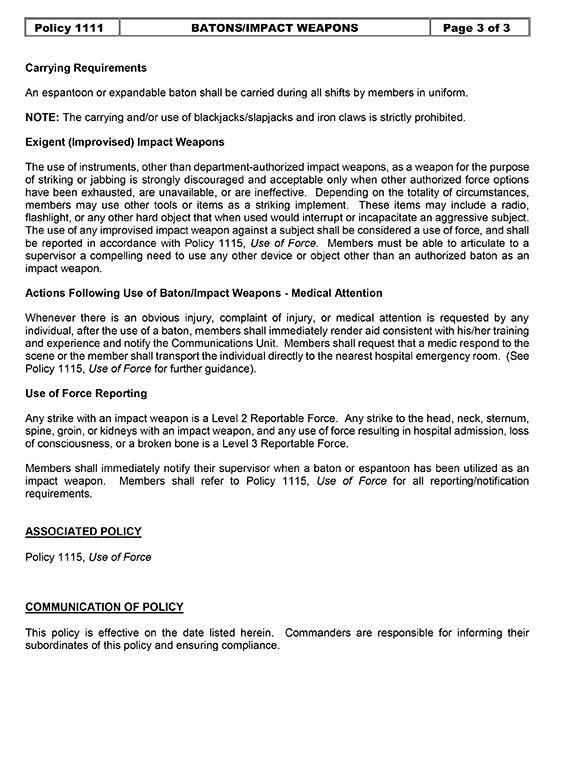Espantoons
 Courtesy Eli Alaman
Courtesy Eli Alaman
22 February 1941 Strike, Baltimore Police
Digital Painting by Ken
Espantoon
Espantoon Info/History
According to Webster's Third Edition, an espantoon is defined as follows: "A spontoon A policeman's club in Baltimore" We'd like to start by saying that we collect nightsticks, Espantoons, batons, truncheons, and Billy clubs, among other things. If you have one for sale or would like to donate one, please contact us, as we are interested. We particularly enjoy the Baltimore espantoon for obvious reasons. Aside from being the stick carried by our law enforcement brothers and sisters, they also show a progression not only in what we carried or made but also in what the department made for us and issued to us. That being said, while we enjoy Baltimore sticks, we collect all sticks, from any state in the United States to any country on the planet.
We've always been serious about the Espantoon, which is why Baltimore City Police is the only police force in the world to use one. Also, if a Baltimore County Officer and a Baltimore City Officer both have sticks made by the same guy (say, Nightstick Joe), why is one guy's stick a baton or nightstick and the other an Espantoon? We asked several old-timers about the nomenclature of our Espantoon over the years. We were repeatedly told that the top part that appears to be the handle is actually the "Barrel Head," followed by the "Thong Groove," the "Ring Stop," and the "Shaft." The word "Barrel Head" could be a mispronunciation that, if pronounced correctly, would have solved the riddle much sooner, but we had to work with what we had! We knew the difference for years but couldn't put it into words. That was until Ken read the question asked by the reporter in a newspaper article one night, and it was a question that flipped the switch in Ken's mind, and once it was, it was like the old saying, "It couldn't be unseen!" We now appear to have more ways to describe or answer the question. So the 1970s newspaperman's question was, "If a Baltimore City Officer gifts his Espantoon to a Baltimore County Officer, is it still an Espantoon?" In Ken's eyes, the answer was no, and as strange as it may sound, it all comes down to training. For years, the satisfactory answer to the question of what makes an Espantoon an Espantoon was, "Webster's 3rd edition dictionary says it is!" That was unacceptable to us, so we dug deeper, reading every newspaper article, general order, and policy. This provided us with what we believe to be the most accurate answers. Everywhere else in the world, the part that looks like a handle is a handle, but in Baltimore City, we turn the stick around, and that handle-looking part is the striking end. If a city and county officer traded sticks, each would use their new stick according to their training, with one having a nightstick with a handle and the other having an espantoon with a burl head. That is what distinguishes a nightstick from an Espantoon. The following is some additional documentation on the subject.
What makes an espantoon, as the old question goes? A nightstick used exclusively by the Baltimore police. Here's the old answer, straight from the pages of Webster's Third Edition:

We couldn't explain what made an espantoon an espantoon until we read a 1970s Sun Paper newspaper article that asked, "If a Baltimore City officer gave his espantoon to a county officer, would it still be an espantoon?" This single question sparked an answer that we'd known for years but had difficulty putting into words for a reasonable explanation. By the way, the answer to the Sun's question is, of course, No! If a city officer gave his espantoon to a county officer, it would turn into a nightstick and cease to be an espantoon. This is why. The espantoon is defined in the Baltimore Police Department's General Orders, or what is now known as Baltimore Police "Policy," specifically in Policy number 1111. A wooden baton measuring 22–25 inches in length has a striking end measuring 1-1/2 to 1-3/4 inches in diameter and a grip end measuring 1-3/8 inches in diameter. For those who are not mathematicians, 1-1/2 - 1-3/4 inches is greater than 1-3/8 inches. The way we hold and use a baton or nightstick is what distinguishes it as an espantoon; other agencies do not hold or use a baton in this manner, making the espantoon unique to a Baltimore Police officer. But what if the county officer turns it around? In theory, it would, except that in Baltimore City, this can be done while remaining within the officer's training; in the county, the officer would be going against his or her training, and thus not only would it not be an espantoon, but the officer could be charged and lose his or her job. So, it's not just that we turn it around; it's also that it's within our agency's rules and training that we do so. Ed Bremer, a woodworker who turned espantoons for city police, once stated that the espantoon comes just before the handgun, so by using it, it has eliminated the need to step up to the firearm. For the record, the espantoon is also used to jab and pry, so one could pry a suspect's arms behind their back rather than strike their arms; jabbing in the stomach rather than swinging it like a baseball bat actually works better and eliminates the need to move up to the firearm; and Mr. Bremer stated, "This saves lives!"
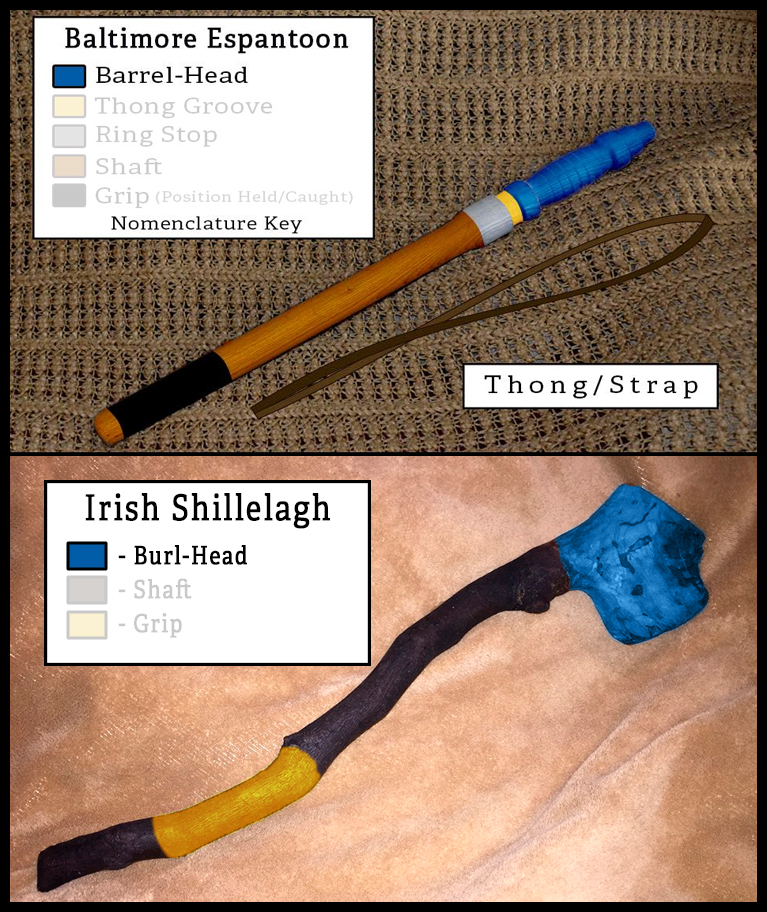 Woodworkers that Turned Baltimore Espantoons
Woodworkers that Turned Baltimore Espantoons
1939 / 2007
1939 / 1957 – Rev W. Gibbs McKenney - Made BPD Issue - Sold to Howard Uniform - 10,000 hickory 2,000 redwood over 20 yrs
1957 / 1977 – Rev. John D. Longenecker - Made BPD Issue - Sold to Howard Uniform - 10,000 hickory 2,000 redwood over 20 yrs
1955 / 1979 – Carl Hagen - Made BPD Issue & his own Stick - Sold to Howard Uniform and Officers - 2.000 various wood types over 24 yrs
1974 / 1977 – Edward Bremer - Made his own Stick – Sold to Officers - 300 various wood types over 3 yrs
1977 / 2007 – P/O Joe Hlafka - Made his own Stick - Sold to Officers and Police Supply Shops - 10,000 various wood types over 37 yrs
![]()

Baltimore Sun, August 3, 1956 - As we know, our police are not striking with the "handle end"; we strike with the "barrel head" per our training, General Orders, or Policy #1111. As you look through the photos on this page, you'll see that, as far back as we could find, officers carried their sticks in a way that would have them holding the handle end of the shaft and swinging the "barrel head," often confused as the stick's "handle end."
![]()
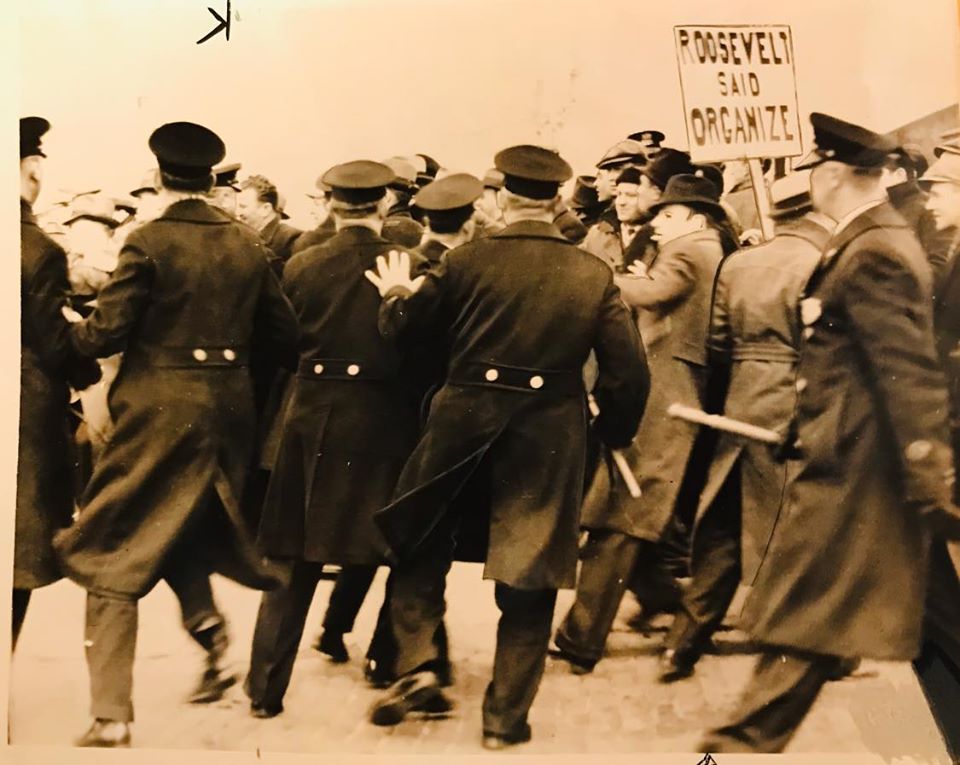
18 February 1937: Taxi Strike
Notice that in both places where we can see the espantoon, the officers are holding the Barrel Head out

Courtesy Robert Oros
Nice espantoon picture showing a nice Baltimore Police Espantoon.
Also, notice it is held at the shaft with the Barrel Head or Striking end out
Above is the article that best helped me put my answer into words about what makes an espantoon an espantoon. To read the full article, click on the picture above, and it will take you to the article. You can click on it after it opens if you need to zoom in.
![]()
Do our sticks measure up?
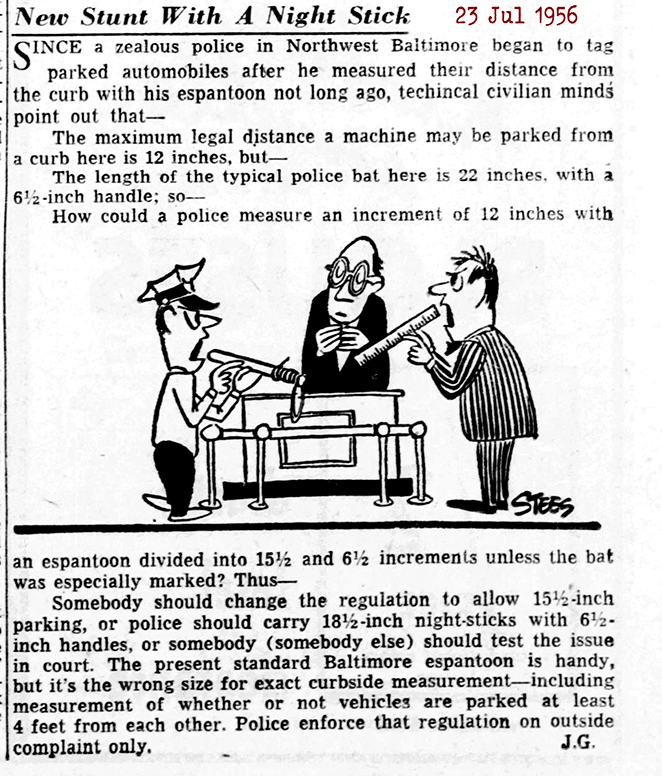
![]()

The blue portion of the espantoon in the above illustration is frequently misidentified as the stick's handle, but it is actually the striking end. It's called a barrel head, which is most likely a mispronunciation, because the striking end of many blunt force weapons is called a "burl head." The blunt end, as in the Tomahawk and other similar weapons, can be added or carved into the weapon. Burl sounds more like Barrel in Baltimore, thanks to years of mispronunciation and a slight southern drawl. As a result, Burl Head was renamed Barrel Head. The shape of the Espantoon’s burl head is also kind of shaped like a wine barrel, which contributed to the error. In the same way that the JEEP, a military vehicle with ties to Baltimore, has a name derived from the letters G.P. for General Purpose G.P. said it often enough and fast enough, and it took on the sound of JEEP. Long before it was manufactured and marketed as the JEEP, it became JEEP and would have been forever called a Jeep with or without the JEEP's we know; similarly, the Burl Head on the striking end of our espantoon will now and forever be called a Barrel Head.
![]()
An illustration with a key shows the often mistaken handle, which is in fact the striking end.
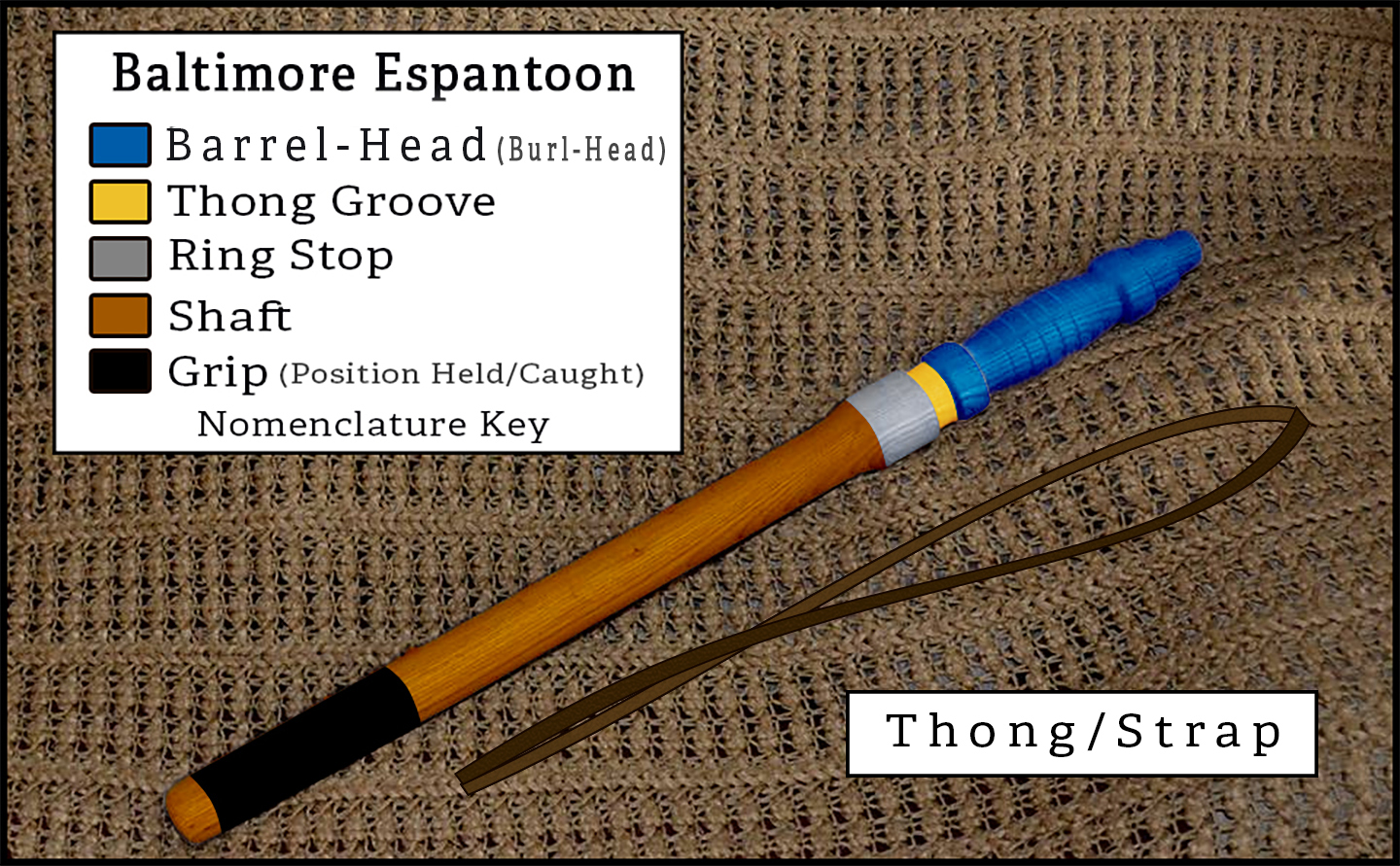
Nomenclature of the Espantoon
We took a Joseph "Nightstick Joe" Hlafka espantoon and painted the various pieces using a color key and the nomenclature with color key in order to make the barrel-head and other sections of the espantoon clear. We can see how the barrel-head can be mistaken for a handle by using BLUE for the burl-head or barrel-head in the illustration above. We can also understand why some older people might assume it resembles a wine barrel and think that's how it got its name. The old-timer genuinely said, "This is called the barrel head, if you look you can see it seem like an old wine barrel," when he was explaining the parts to me when I was a young officer. The "thong groove," which is where a leather tong is woven to prevent it from falling off the stick, can be seen if we look at the part of the stick that is painted yellow. In addition to being a component of the "thong groove," the area under the groove that has been painted grey is the "Ring stop," which serves to keep the espantoon from slipping through the nightstick ring on an officer's belt. The shaft, which is located behind the "ring stop," is stained the same color as the stick until we reach the "grip." On certain sticks, the grip can be turned into the stick, but most of the time it is just the area of the stick where we feel most comfortable grabbing it. For each person, it might be balanced differently. The Thong or strap, which is seen in the image, is also utilized differently. For me, I like to loop it over my ring finger, but I've also seen people loop it over their middle finger or even around their entire hand. To determine what works best for us, we must all test it in different ways.
Looking at the pictures below, we can see that the Baltimore Police carry what is known to them as the espantoon. It is carried in a way that keeps the barrelhead at the ready. Tucked under the weak arm with the striking end extending out toward the officer's back, it leaves the grip end ready for the officer to grab or grip with his or her strong hand in the event that it might be needed. In photograph A) we see it in the officer's strong hand. If necessary, he could turn his hand downward with the thong over a finger of the strong hand, allowing the stick to slide out until stopped by the strap. This would put the stick in his hand by the grip end, with the striking end out, and at the officer's ready. Photograph B) is as described above, tucked under the weak arm, ready to be grabbed with the strong hand at the grip end, which would leave the striking end again at the ready. Photographs C) and D) are similar in that the officer's stick is held in the strong hand, with the thong over a finger, and the stick is held at the halfway point, or so, with the striking end pointing forward, allowing the officer to simply loosen their grip while the stick slides forward until the thong brings it to a stop, at which point the stick would be ready for use. The important thing about Photograph D) is that the stick is behind the officer's back, so while he is holding it at the ready, he is not doing anything that could be seen as a threatening move to provoke confrontation. We can now see why these 4 pictures are a nice representation of how a Baltimore officer can always be ready to protect himself or the public without walking around in a way that might be seen as or used as an excuse to claim it as having been threatening. Compare the way a Baltimore officer holds the espantoon to the way other juristictions hold their nightstick, or billy clubs.
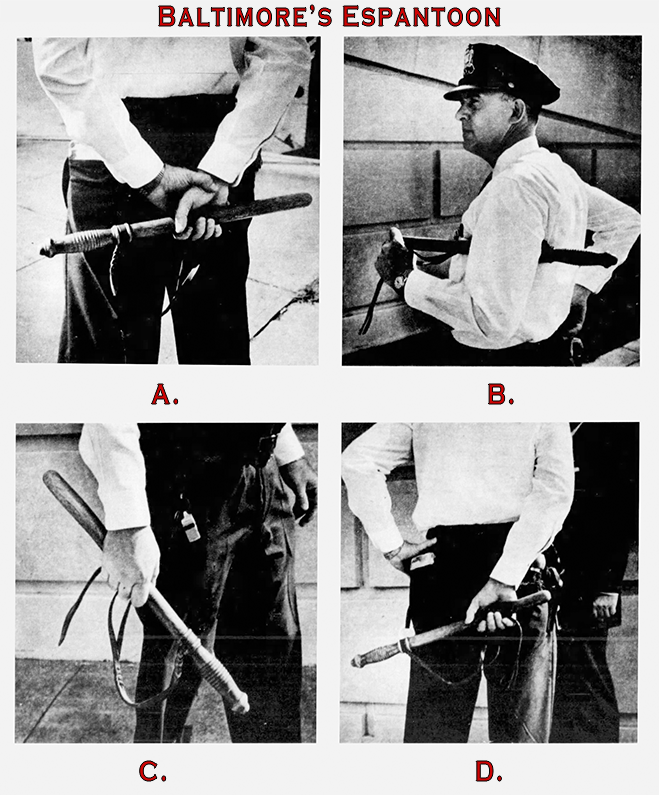
NOTE: We added a few non-Baltimore Police images to show how other law enforcement agencies handle their batons, nightsticks, and other items. When you carry something the way we do, it quickly strikes us as strange when we see someone else carry it backwards or upside down. For those who could be interested, this will be a pleasant educational experience, and for those who don't grasp it or don't understand it, there may even be some lightheartedness.

This is the difference: These officers are not Baltimore Police
They are not wielding an Espantoon in Baltimore; this would be considered
The Wrong End of the Stick
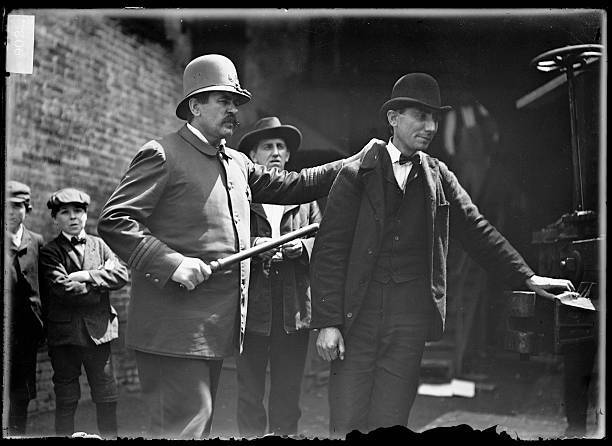
This is the difference: These officers are not Baltimore Police
They are not wielding an Espantoon in Baltimore; this would be considered
The Wrong End of the Stick

The barrel-head, or section of the stick, is denoted by the letter "A" in the image above. Take note of how much cleaner the center of the barrelhead is than the shaft, particularly the area we have designated with the letter "B" on the shaft. Lines have been drawn at the top and bottom of the section we have labeled with the letter "C." Although this section is very dirty, it is not as filthy as the section we have labeled with the letter "B." This suggests to us that the Officer handled it frequently in the area designated "B," which may be a sign that the Officer rotated the stick as he moved about his post. When spinning a stick, that portion would most frequently be in the hand due to the frequent catches and releases. A stick with a little stain and no clear coat will pick up and keep the most filth after absorbing oil from the hands. Particularly when there is no swivel, the stick must be seized and released more frequently to keep it moving and keep it from tangling up upon itself. The stick was most likely carried in the strong hand, as can be seen if we look at it between the area marked "C." While many guys just utilize their strong hand, some guys learnt to spin or twirl with their weaker hand. Because other agencies do not permit an officer to carry an espantoon the way a Baltimore police officer would, this aids us in not only dating the stick but also demonstrating how it was handled. Every handprint also reinforces our belief that this was a Baltimore issued espantoon spun by a Baltimore officer.
Looking at the previous image, which features the Officer in four different poses, we can see that his hand is typically resting in the middle of the shaft. Now we have to add to the gripping of the stick, at the shaft, what happens when the stick is actually used, either to strike someone, jab someone, or pry their arm, perhaps from behind their back, or from being wrapped around someone's neck or body. When someone is fighting an officer's attempts to subdue them, it also works to place them in an arm bar before either walking them to the wagon or handcuffing them. How an officer responds depends on whether the person is resisting while trying to run or resisting while attacking the officer. This implies that an officer's actions are frequently motivated by the person being detained.

Courtesy Eli Alaman
22 February 1941 Strike, Baltimore Police
Looking at the back of the Officer closest to us, we can see where his Espantoon comes from under his arm confirming that even in the 1930s the "barrel head," end was the striking out. Showing that as far back as the 30's Officer held the stick by the shaft, striking with the Barrel Head.

Courtesy Eli Alaman
22 February 1941 Strike, Baltimore Police
If we look at the four-picture group, in particular, the second picture, the one marked with the letter "B," we'll see how the stick was most frequently tucked up under the Officer's weak-arm. We'll take another look at these images and others to better understand what is meant by "carried at the shaft." In contrast to the image that the majority of guys, including myself, saw, in the "A, B, C" image, the strong hand extends up and over to hold the stick in the area that was previously denoted by the letter "C." My favorite image is the one below, which shows an officer getting back into his car with the barrel-head extended and his hand at the grip end of the shaft.
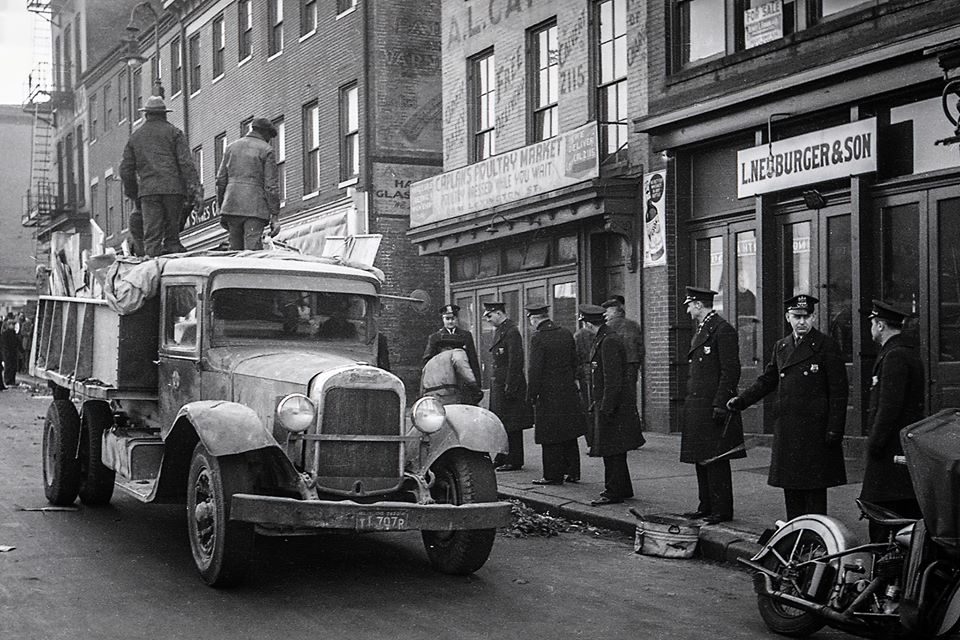 Courtesy Eli Alaman
Courtesy Eli Alaman
22 February 1941 Strike, Baltimore Police
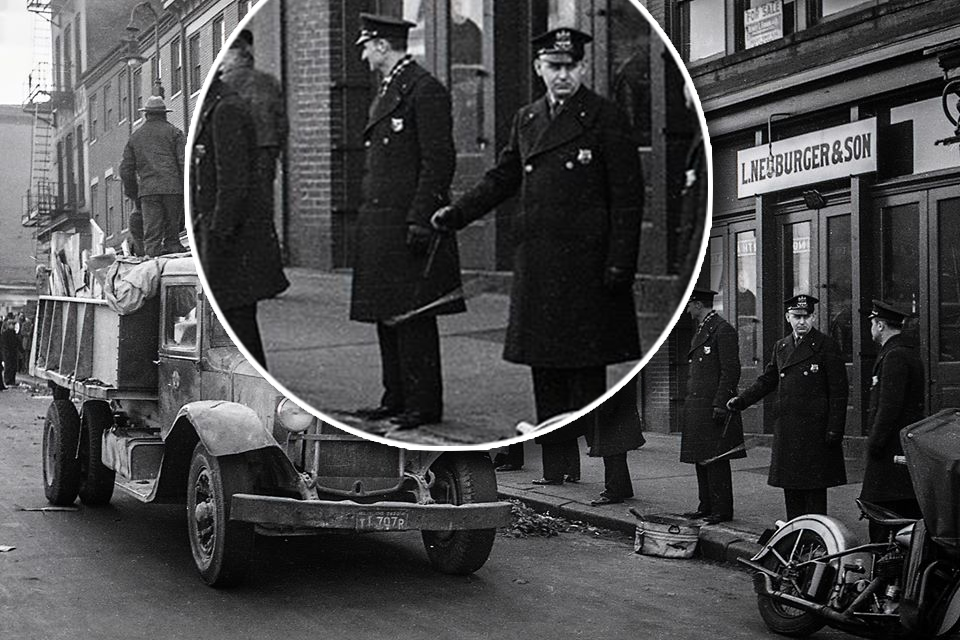 Courtesy Eli Alaman
Courtesy Eli Alaman
22 February 1941 Strike, Baltimore Police
Take a look at the officer in the bubble, he is spinning his espantoon on the end of the thong/strap, very nice picture giving the year of the pic (1941) it is nice to see it being done so long ago. This pic was taken by Eli Alaman
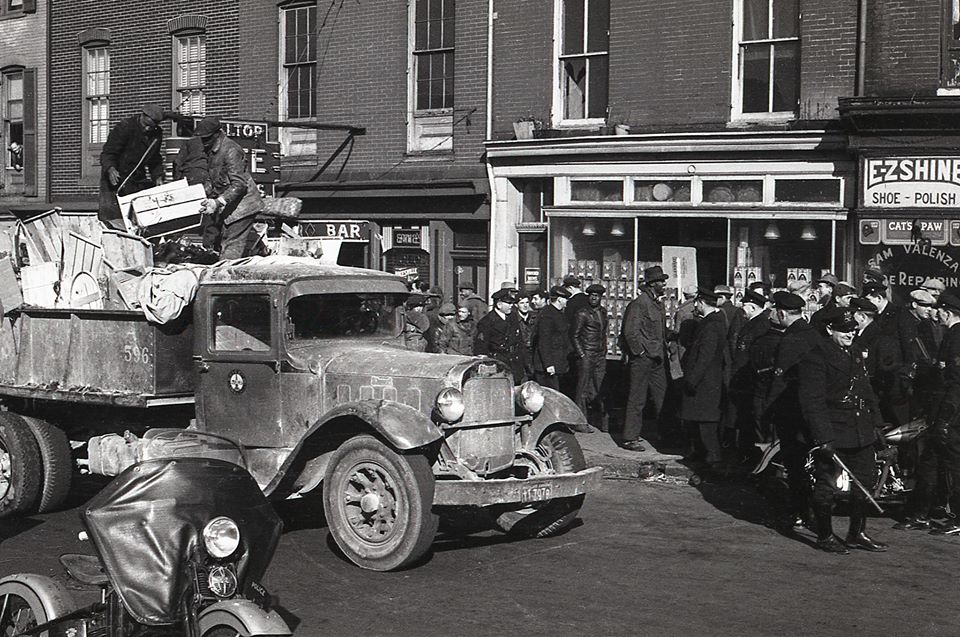
Courtesy Eli Alaman
22 February 1941 Strike, Baltimore Police
Taking a look at the motor's officer walking toward the right side of the pic, he is holding the stick at the bottom of the shaft, with the barrel head out front and away from his hand, looking close you can see, he is one of the guys that carved the barrel head so it was no longer convex, a lot of guys would reshape their espantoon to make it unique to them.
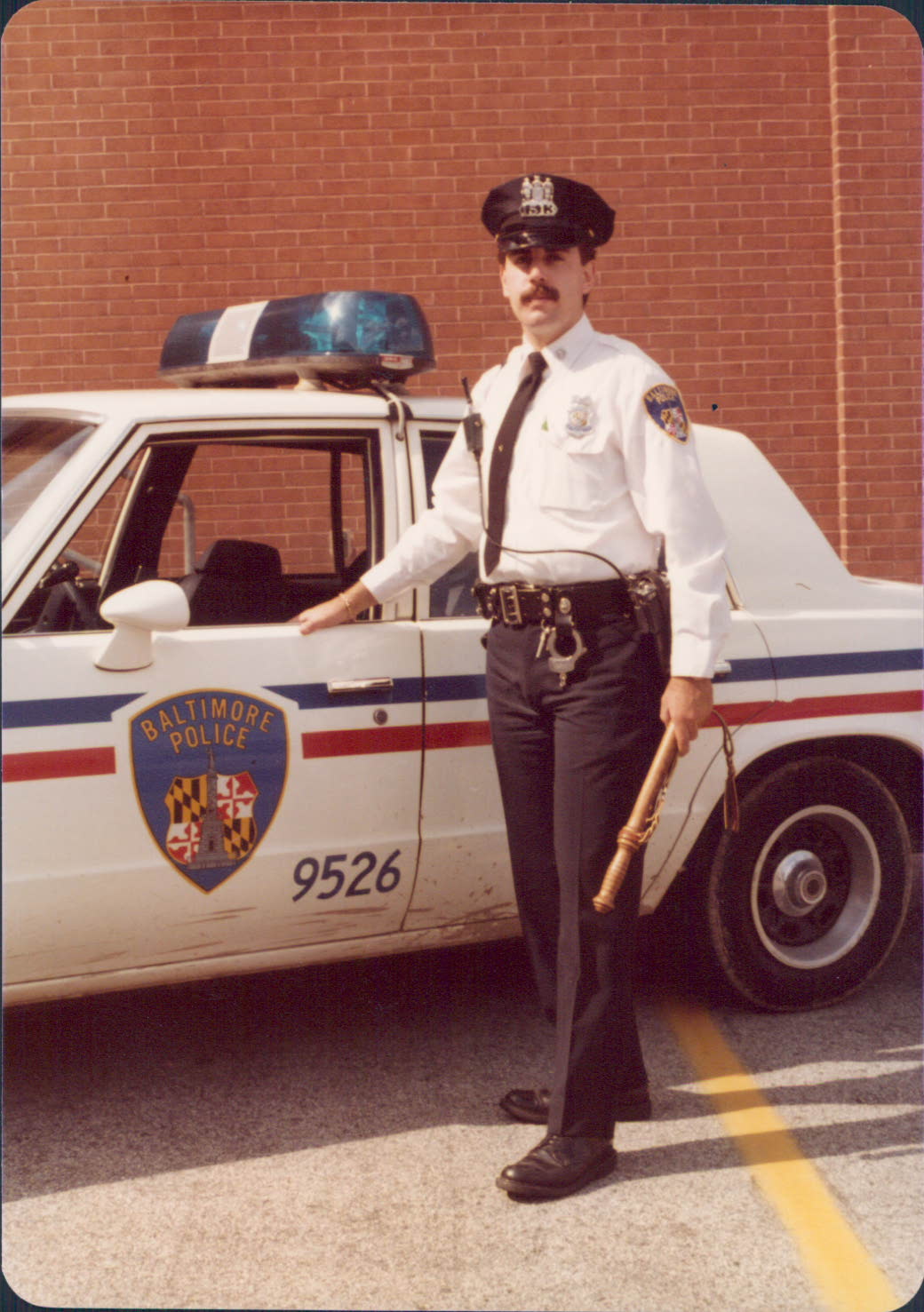
Courtesy Robert Oros
Nice espantoon picture showing a nice Baltimore Police issued espantoon.
Looking more closely we can also see he had a swivel added to the thong.
![]()
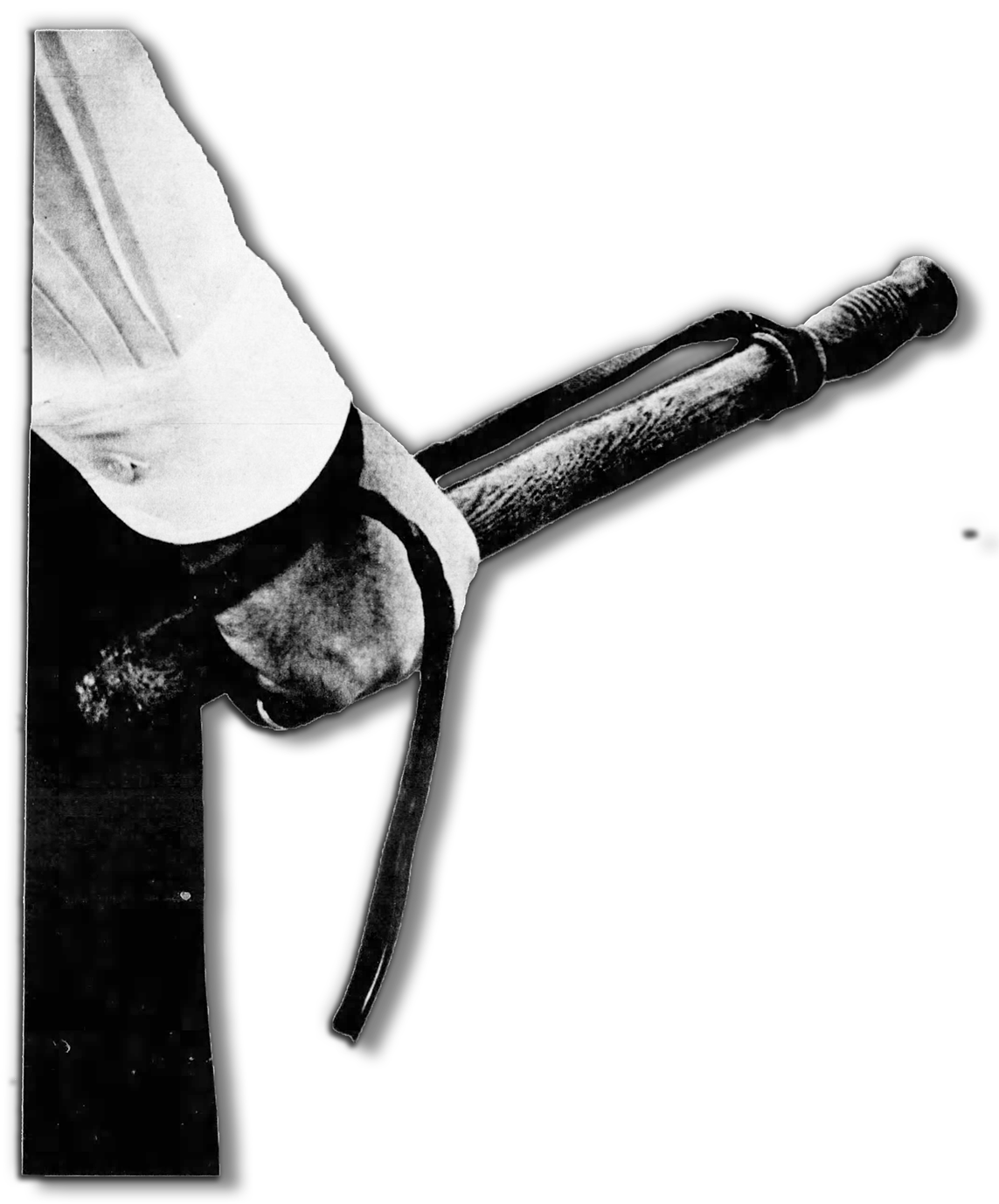
This is a most commonly used "Striking-position," it is also a catch, and or release position of holding the stick when spinning/twirling the espantoon.
1861 Baltimore Police dressed in plain clothes and were distinguished by
a pink ribbon on their left lapel, and an espantoon in their hands
CLICK HERE OR ON PIC ABOVE FOR FULL SIZE ARTICLE
This clipping was taken from a 28 June 1861 Sun paper. Notice it says
"New Police force was appointed in the several districts, under military authority..."
"Newly appointed policemen were designated by a Pink Ribbon, and
they carried the usual Police Club" which in Baltimore is the Espantoon
TO SEE FULL PAGE CLICK HERE OR ON THE ABOVE ARTICLE
![]()
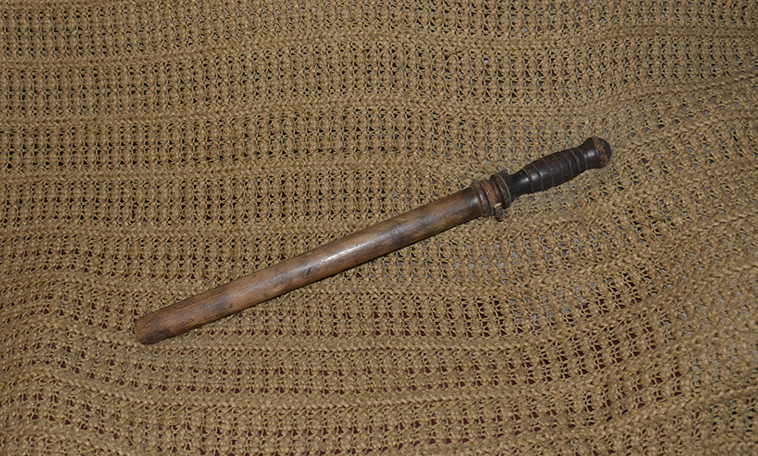
Reverend McKenney and Reverend Longenecker
This is a vintage espantoon from the Baltimore Police Department that was produced between 1937 and 1977 by either Rev. W. Gibbs McKenney or the Rev. John D. Longenecker. An interesting meeting took place when the elder reverend [McKenney], who had spent years turning police sticks for Howard Uniform to be given to men of the Baltimore Police, decided to retire. When the second reverend [Longenecker] saw the listing, the tools were already gone. Reverend McKenney had already decided to give his tools to a boy’s school, but he told the second reverend that if he was interested and could gather the necessary tools, he would help get him the Howard Uniform Espantoon Contract. Soon after, the two reverends were together, with the senior reverend teaching the junior reverend his tricks for turning the Baltimore Espantoon. Since he was a young child working at his family's furniture manufacturing company in Pennsylvania, the younger pastor had been turning chair parts on a lathe (it was his job to turn the rails for the chairs his father, and older brothers were making.) He quickly learned the pattern, and best of all, he could turn them from memory. According to a family relative, he simply put the one stick he received from Reverend McKenney on a wall nearby his lathe, and all of the sticks were quite similar. If I recall correctly, the second Reverend claimed that turning a stick initially took him an hour, but that once he was ready to begin, he was able to turn three or four sticks in the same hour.
![]()
Click HERE or the above Article 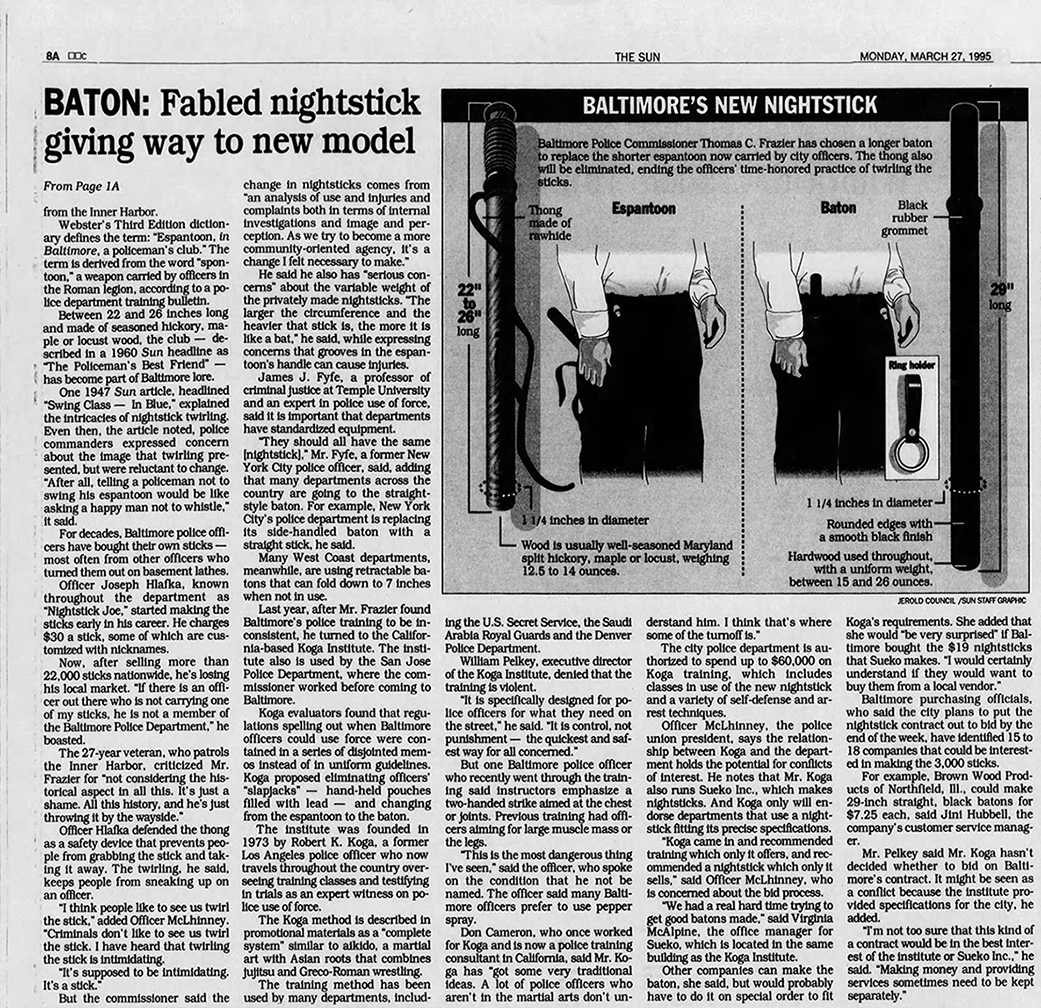
Click HERE or the above Article
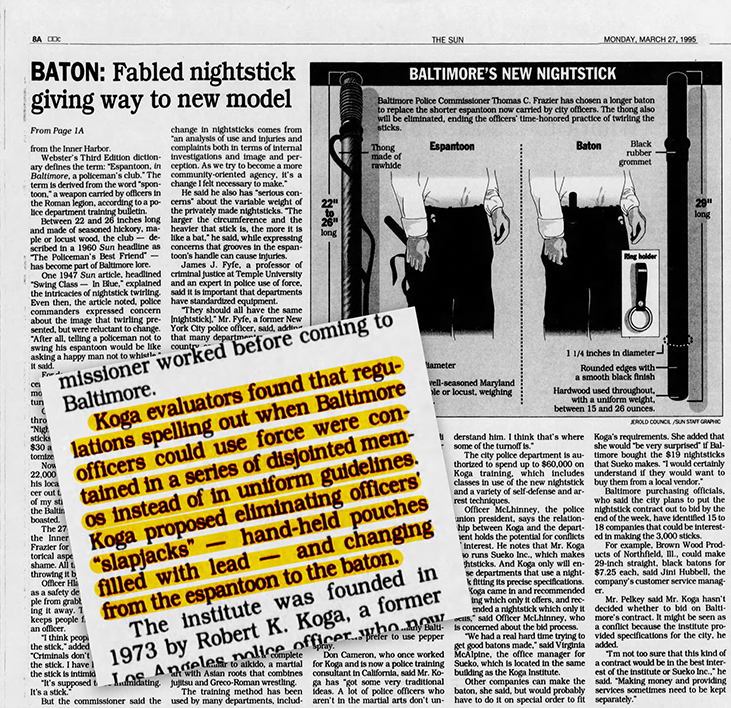
![]()

Look at where the stick is most frequently held, and we'll see why the handprints are where they are and how this is a Baltimore thing. We have and will continue to see this photo on the site. Go get your stick, or the next time you pick one up at a flea market or antique shop, search for these telltale indicators. If we read our general instructions, we see numerous paragraphs explaining the several batons allowed in use by the department. When they describe the espantoon, they describe it as follows. After all, no other agency had their officers turn a nightstick around and use the handle as the business end. The espantoon is a wooden baton that is between 22 and 25 inches long, with a striking end that is 1 1/2 to 1 3/4 inches in diameter and a grip end that is 1-3/8 inches in diameter. Only an Oak, Ash, Maple, Hickory, or Rosewood finish may be applied to this baton due to its color restrictions. Decorations are not permitted.
NOTE: We are not claiming that we won't find marks where officers from other agencies didn't carry their batons at the shaft; rather, we are claiming that, in most cases where the stick is not straight and does have a handle, the handle will not be as clean as the Baltimore Espantoon's Barrel head or Burl-head.
To further appreciate what makes a Espantoon, a Espantoon, we must evaluate the differences between a nightstick carried in New York, Chicago, Philadelphia, or by any other police officer in any other police department anywhere in this country. In essence, a Chicago stick could be distinguished from other sticks by the distinctive turning pattern of its handle. Baltimore may not have a pattern for optional officer self-purchased sticks, but the provided sticks were the same style from 1937 until 1992. The sticks weren't all that different before 1937; nevertheless, the quality was a little more appealing. A Baltimore baton might be easily selected from a throng of sticks if either the older versions or the more contemporary variants were placed on a table with other batons from across the world.
![]()
Below are Some Baltimore Police Issued Espantoons

1920's Baltimore Police Issue

Issued Stick 1937 - 1977
Rev. W. Gibbs McKenney & Rev. John D. Longenecker
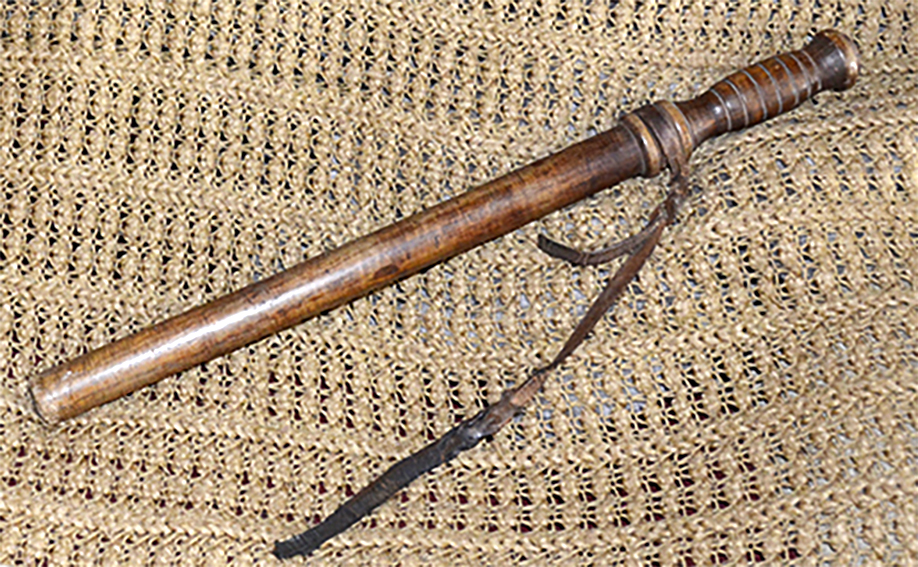
Issued Stick 1937 - 1977
Rev. W. Gibbs McKenney & Rev. John D. Longenecker

Issued Stick 1937 - 1977
Rev. W. Gibbs McKenney & Rev. John D. Longenecker
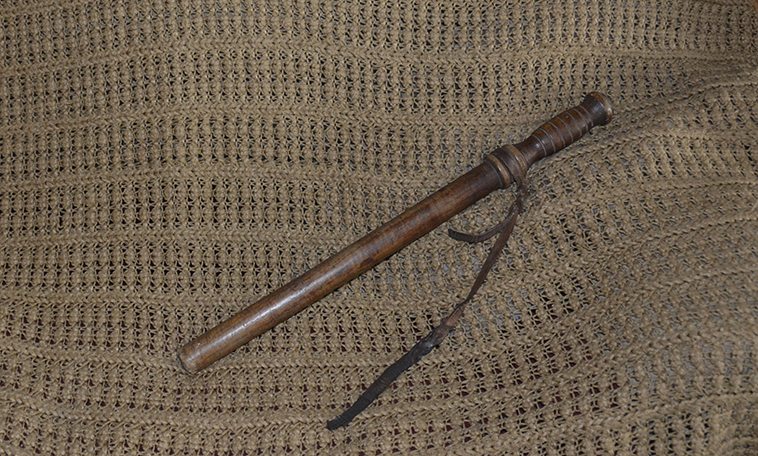
Issued Stick 1937 - 1977
Rev. W. Gibbs McKenney & Rev. John D. Longenecker
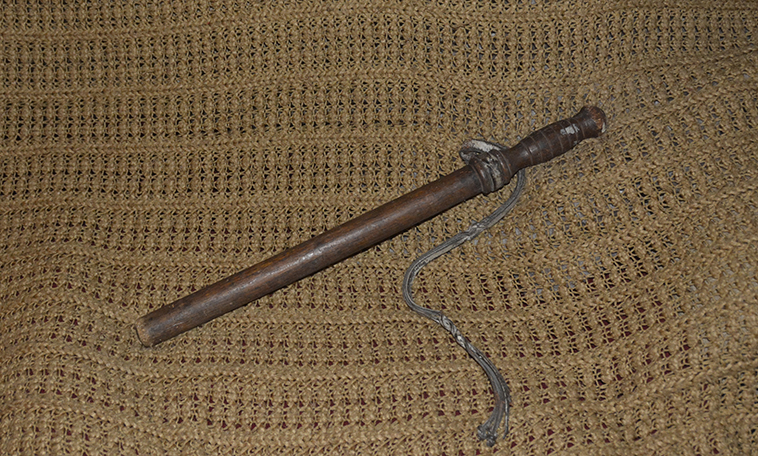
Issued Stick 1937 - 1977
Rev. W. Gibbs McKenney & Rev. John D. Longenecker

Courtesy David Eastman
Look at the officer's espantoon seen on the right side of this pic, and notice how it is carried, held in his right hand with the thong ran through his fingers, and the barrel head out as he is gripping it by the shaft of the espantoon. This pic is taken in the early 1900's but we can clearly see he carries it the way it is carried today, indicating the striking end back then, was as it was in the 1960's and 1970's when Ken's uncles walked a beat in Baltimore, and the 1980/90's when Ken walked a beat in Baltimore. The striking end in Baltimore would be considered the handle to all other jurisdictions, and if other departments used it the way Baltimore did, it was only Baltimore that had it in the officer's general orders that the striking end was the wider end of the baton, the handle in Baltimore is the thinner end, the end known here as the "Shaft."

Issued Stick 1937 - 1977
Rev. W. Gibbs McKenney & Rev. John D. Longenecker - This has one edge shaved flat so it would stay in place without popping out every time we turn a sharp corner or hit a pothole. The flat spot helps keep it in place when it's forced between the dashboard padding and the transmission hump.

Issued Stick 1937 - 1977
Rev. W. Gibbs McKenney & Rev. John D. Longenecker - There was a time in the mid 50's that officers would shave the Barrel Head of their Espantoon Taking it from convex to flat/straight then add or re-cut grooves in the new Barrelhead
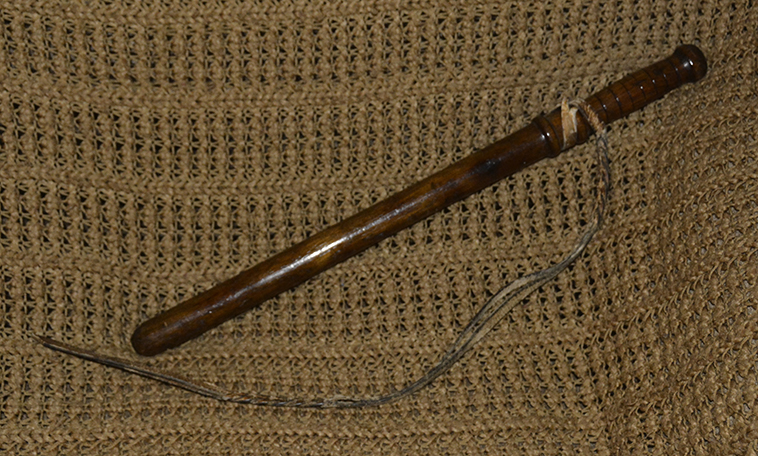
Issued Stick 1937 - 1977
Rev. W. Gibbs McKenney & Rev. John D. Longenecker - This is another case of someone attempting to straighten the convex, "Barrel-Head"

Issued Stick 1987
This was issued to me on 17 June 1987 when I was hired and sworn in

Issued Stick 1937 - 1977
Rev. W. Gibbs McKenney & Rev. John D. Longenecker

Issued Stick 1937 - 1977
Rev. W. Gibbs McKenney & Rev. John D. Longenecker
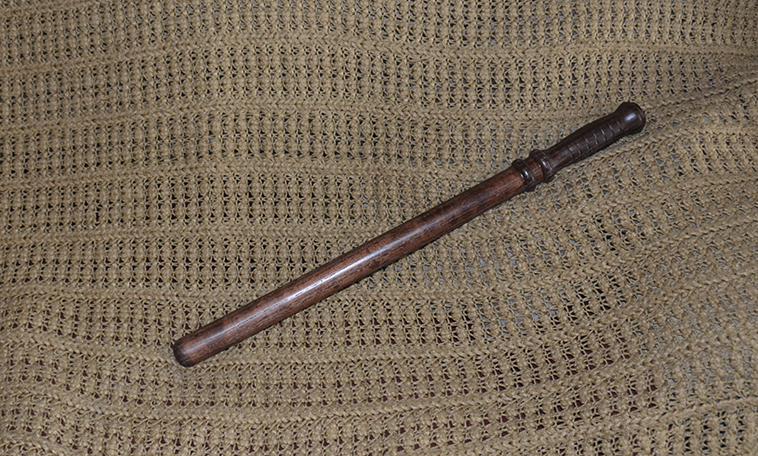
Jim Brock
Perfection Collection
Rev. W. Gibbs McKenney & Rev. John D. Longenecker Model Circa 2015
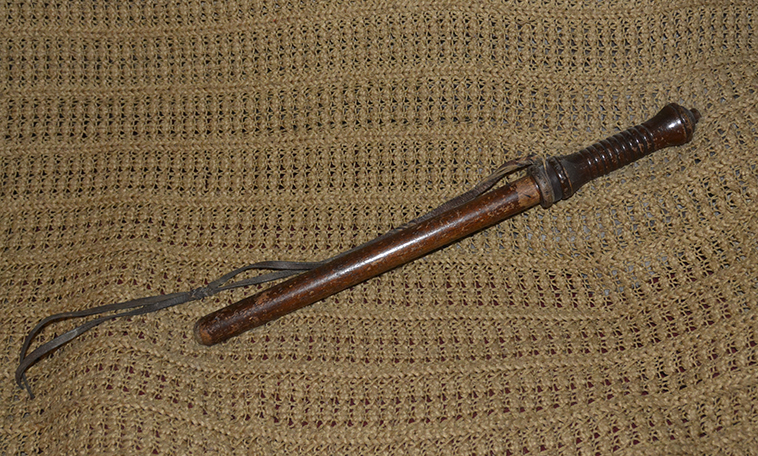 Non-Issue Stick 1937 - 1977
Non-Issue Stick 1937 - 1977
Rev. W. Gibbs McKenney & Rev. John D. Longenecker

Non-Issued Stick 1937 - 1977
Rev. W. Gibbs McKenney & Rev. John D. Longenecker
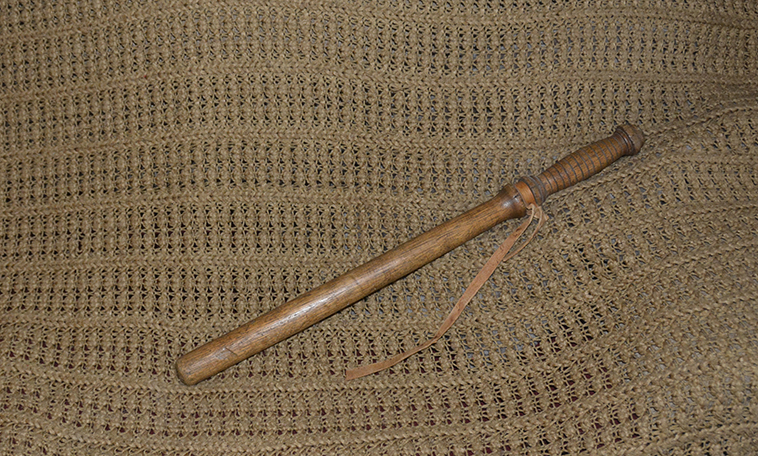
Carl Hagen turned sold through Howard Uniform
circa 1965
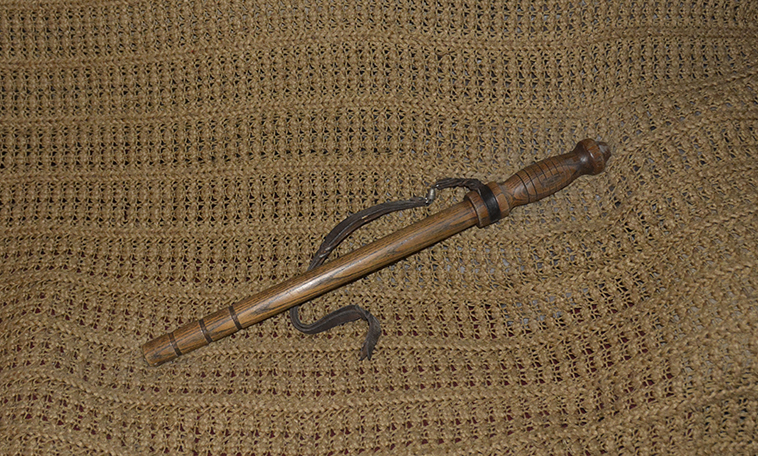
Carl Hagen
This is an early Carl Hagen Stick, it came while he was still turning them to the size of an issue stick, and isn't too far off of the standard issue stick, he just added a few things to make it stand out from the issue stick, the barrel-head is a little over sized and it is turned from an oak.
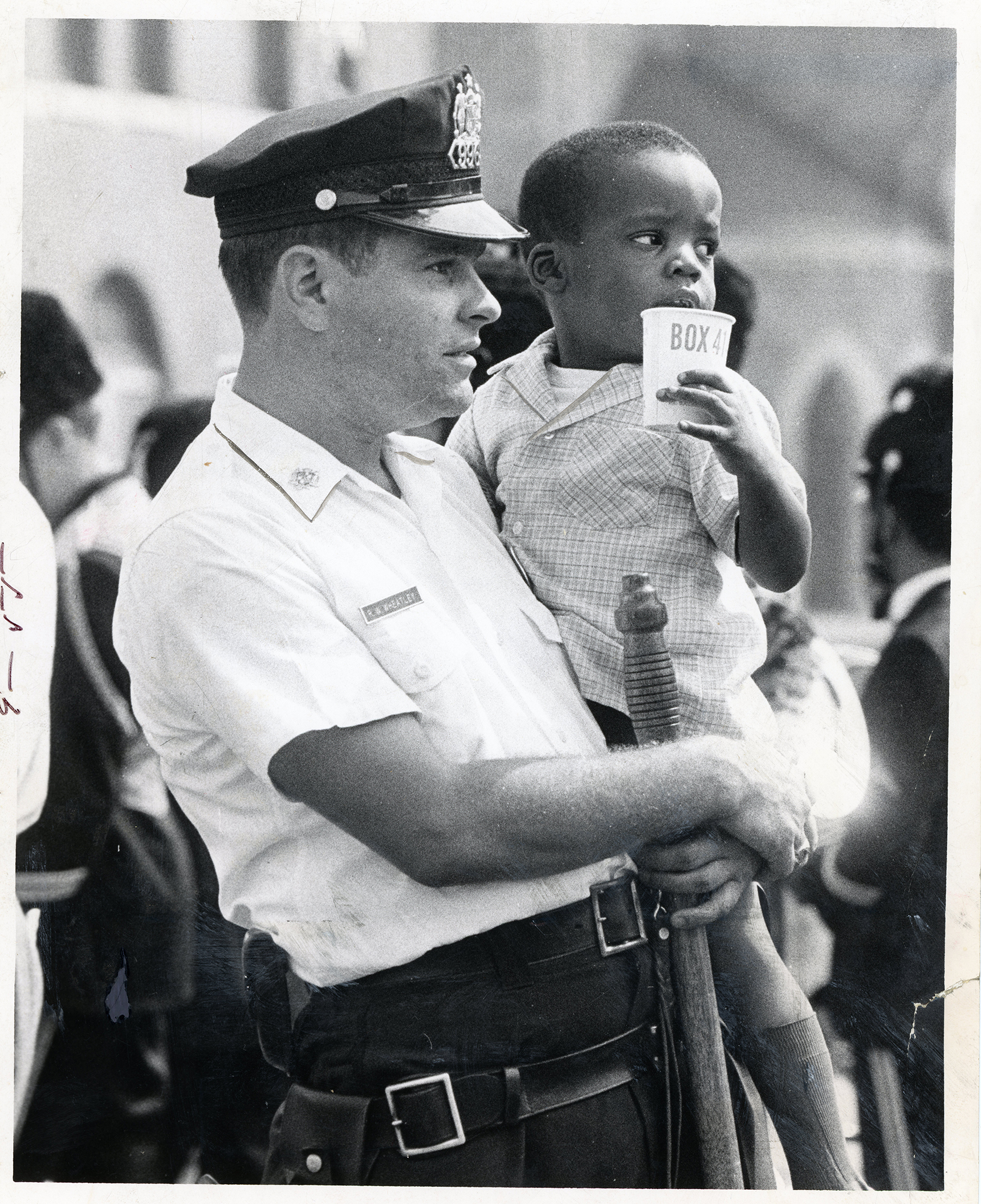
P/O Raymond Wheatley holding a Carl Hagen stick, notice how Carl rounded the tops of his sticks, this is a nice old stick. Also, notice how Officer Wheatley picked up a small child to help him better see a parade that he had attended, but couldn't enjoy over the crowd. Officer Wheatley not only gave the kid a lift, bought him a cup of soda too.
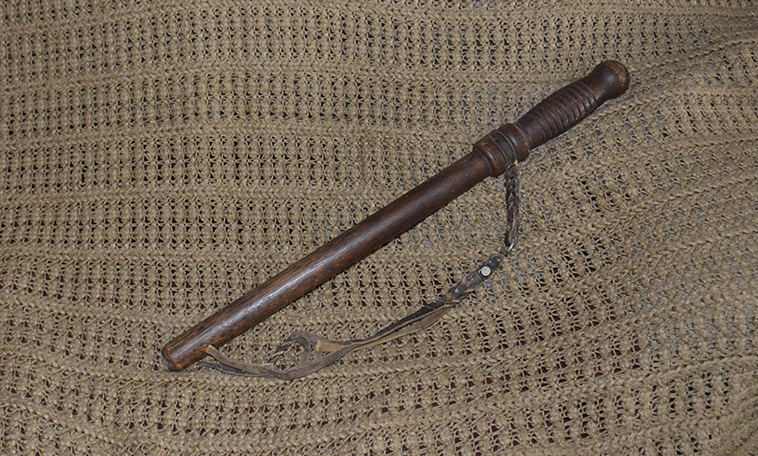
Carl Hagen
1955 - 1979
This is one of Carl's first unique designs, it was done solely by him and became a popular design from his sticks. In the next pic, we'll see Officer Ray Wheatley holding a Carl Hagen Espantoon, it is more of an issue cut, but with a modern (at the time) cut, the cut that ended up being refined into the sticks we saw turned by Ed Bremer and Joe Hlafka.
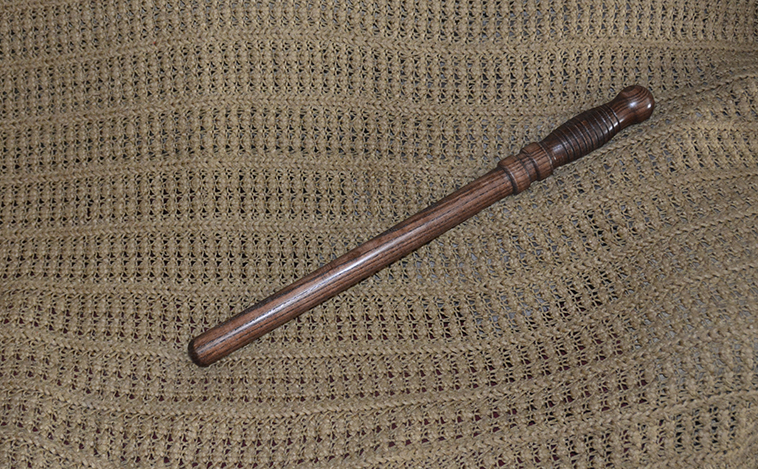
Jim Brock
Perfection Collection
Carl Hagen Model
Circa 2015
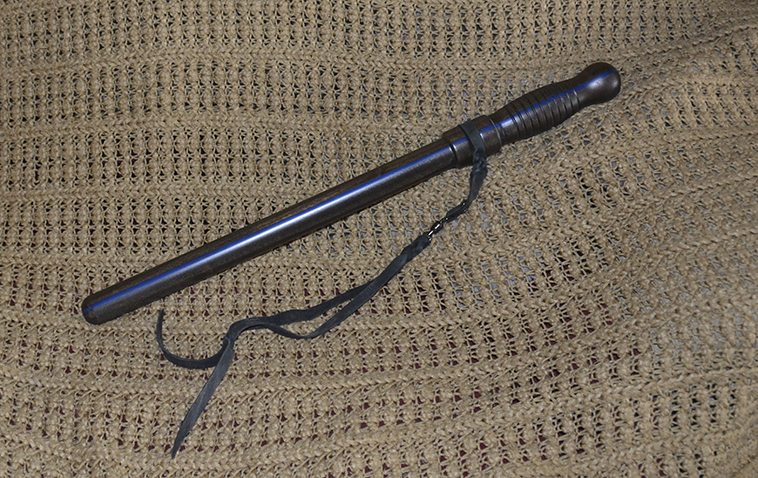
Jim Brock
Perfection Collection Thin Blue Line Stick
Carl Hagen Model
Circa 2015
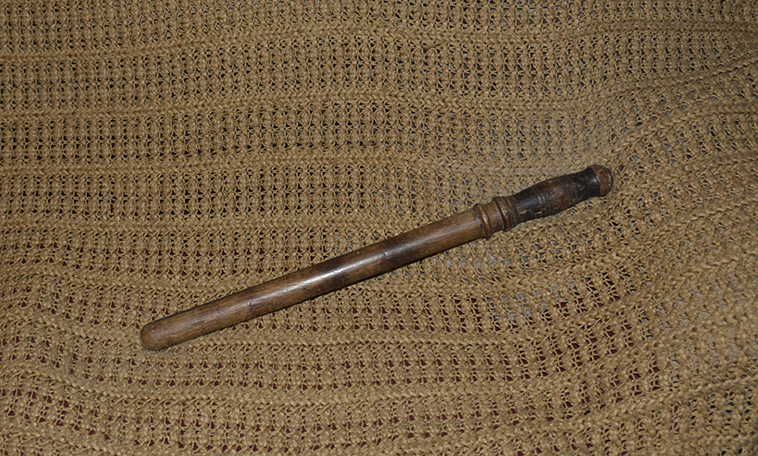
Prior to Issued Sticks 1954 - 1960
Rev. W. Gibbs McKenney & Carl Hagen
At some point when McKenney had retired from turning sticks, he had donated his lathe and tools to a boy's school out west, and before meeting Reverend Longenecker, McKenney he had met Carl Hagen and showed him how to turn sticks, for whatever reason, Carl turned some sticks for Howard Uniform, he just didn't get the 500+ stick a year contracts from Howard Uniform that the Reverends McKenney & Longenecker received.

Carl Hagen
1955 - 1979

Jim Brock
Perfection Collection Lignum vitae #001 Stick
Lignum vitae is on top 10 lists of hardest woods depending on the list it is either 2nd or 4th One might be how dense the wood is, while the other might be how dense the guy/gal is that is trying to spelling Lignum Vitae Joe Hlafka Model Circa 2015
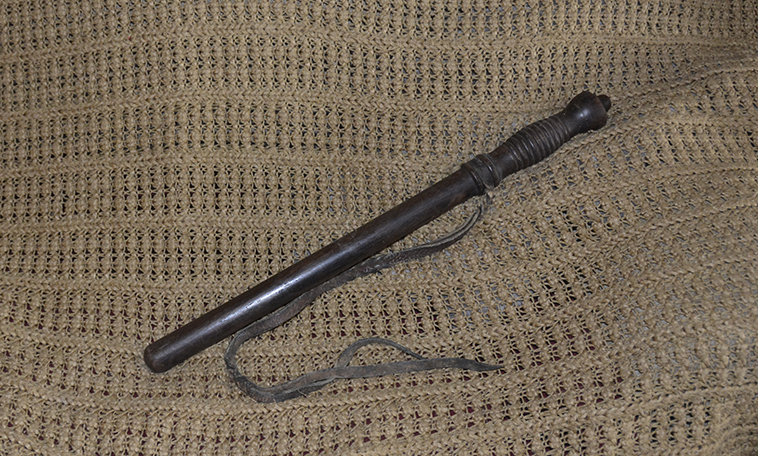
Ed Bremer
1974 - 1977
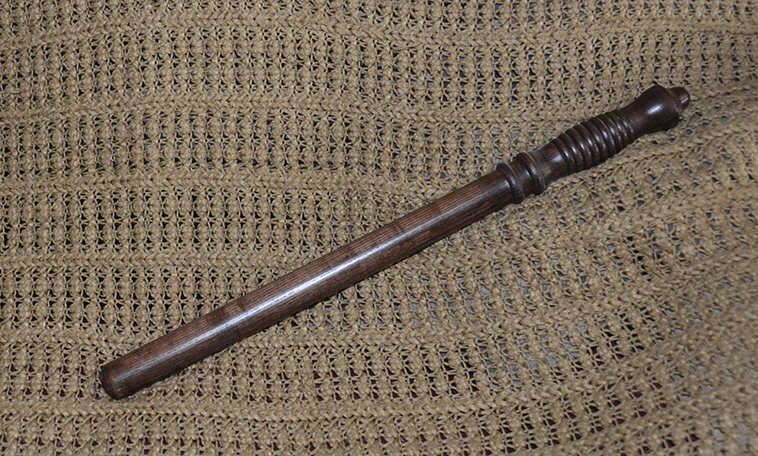
Jim Brock
Edward Bremer Model
Circa 2015
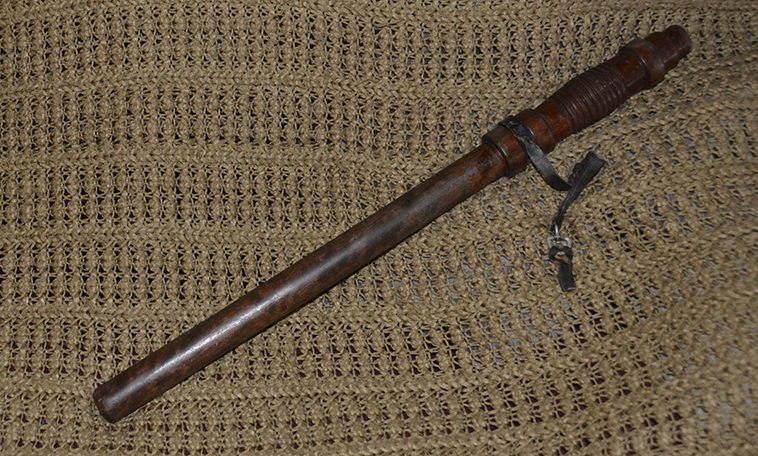
1977 - 2007
P/O Joe Hlafka

Joe Hlafka
1987 - I bought this from Joe Hlafka direct, apparently someone ordered it, paid half down and before it was done they found their stick and told Joe, they didn't need it anymore, could he sell it to someone for the remainder of the balance, I was the lucky guy that talked to Joe about a stick, and he gave me the stick for $12.50. I have replaced the thong twice, had it, "I say" stolen once, the guy that took it, called it, "found". How you can find an espantoon in the trunk of a patrol car, and not think it must belong to someone. Not to mention DRISCOLL is written around the stick in blue sharpie by the Ring Stop - Anyway, it is a 30 plus-year-old stick. BTW I stopped the kid as he was going out to his post, so I loan it to him for the shift, and told him to get it back to me, "in my hand," the next day. I couldn't send him on the streets without a stick.
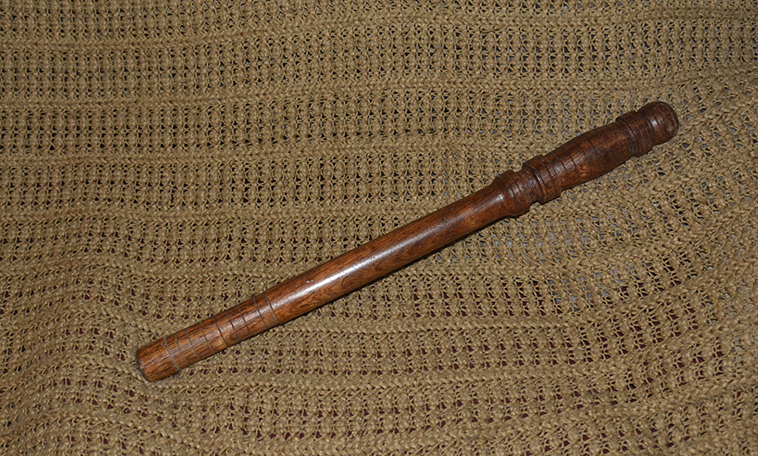
I Turned this Myself
1990 - I put the extra groove on the shaft because after carrying it for a day or two I realized the stick felt good, weight was nice, but the shaft was too think to hold on while swinging it, So I taped the thong to the barrel-head with Duct tape, and put the stick back on the lathe and shaved a hand-grip in the shaft. After shaving the shaft to a comfortable grip, I was done, pulled the tape, and it was a spinner, or umm, I mean a winner,
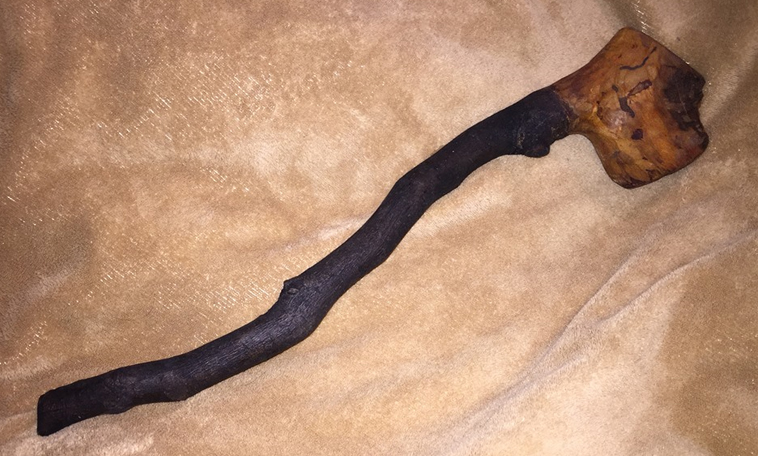
Irish Shillelagh
This is to point out the striking part of this weapon, that blunt looking rock, or fist shaped portion at the end of this weapon, and any blunt force weapon is called the "Burl-Head". On the Espantoon the blunt striking end resembles, and is often mistaken for the weapon's handle is called the "Barrel-Head." Most likely stemming from a misunderstanding caused by Baltimore's southern drawl, or bad "accent," causing a listener to misunderstand what a speaker may have said, Burl-head to thinking the speaker said, "Barrel-head." In 1987 when an old timer told me, he even pointed to the shape and, said, this is because this looks like an old wine barrel. Truth be told, it wasn't a barrel at all, it's a burl.

Barrel Head
This is the Barrel-head of one of Carl Hagen's early sticks - This Rounded off top end was exclusive to Carl Hagen, and was found more on the West side of Baltimore than the East. The East-side Espantoons saw more of a two or three tiered layers each with a hard edge that sat atop the espantoon like a crown on top the barrel head end of the stick. If we look at Carl's earlier stuff, he had a two or three-tiered top edge also, but it wasn't a hard edge. Carl had a super soft, smooth transition going tier to tier on the barrel head.
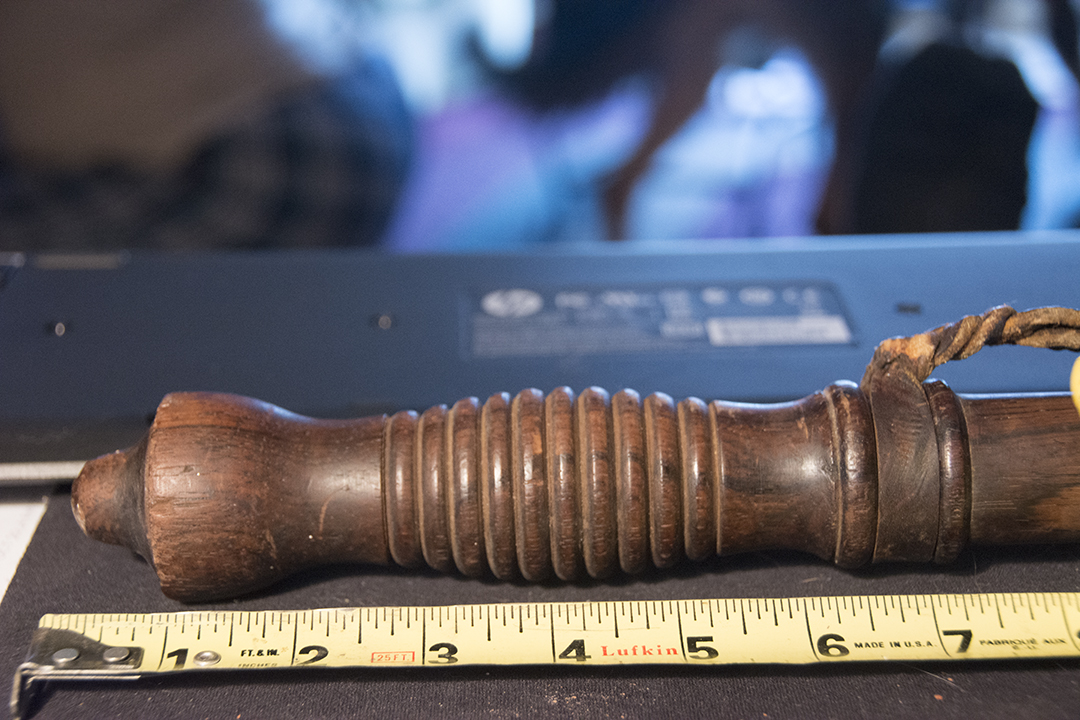
Barrel Head
This is the Barrel-head from one of Ed Bremer's early sticks, he put what he called a "Nib" on the top of all his Barrel head. Mr. Bremer felt he saved lives, both of Officers and Suspects because as he once said, "Nightsticks Save Lives, Preventing Officers from a need to escalate from hand-to-hand combat to the use of a firearm." The faster we can get a suspect into cuffs the safer it is for both the officer and the suspect. This stick is turned from Lignum vitae, a wood that was banned by the department as it was too heavy, hard and they felt could cause serious injury or death.

The Barrel-head of Baltimore's Issued Espantoon
Interesting Theory – In 1957, when Reverend John D. Longenecker began producing them for Howard Uniform, the espantoon issued by Baltimore adopted its final design. If we look, we can see that the Reverend gave his version of our Espantoon’s barrel-head seven grooves. While there is no proof and it cannot be verified, some officers at the time of the change noticed and believed it was because there were only seven districts at the time. Since the Southeastern District wasn't added until 1959 and the Western District was closed in 1951, we only had seven districts in 1957. The Southeast District opened around the same time that the Western District did. As a result, we only had 7 districts for a long time. We only had 4 districts when we first started, and over the years, that number changed several times. If we go back far enough, we can see this. Therefore, during the course of our department's history, the number of districts has fluctuated. But there were just seven districts when Reverend Longenecker began rotating the Espantoon. Was it just a coincidence, or could that be the reason he made the barrel-head of his rendition of Baltimore's Espantoon out of the seven grooves?

BALTIMORE POLICE DEPARTMENT TRAINING BULLETIN
Guidelines EDWARD T. NORRIS POLICE COMMISSIONER
December 12, 1987
Vol. 12, No. 10, August 2002, Revised/Reviewed
ESPANTOON HISTORY – According to Webster's Dictionary, an espantoon is "a policeman's nightstick in Baltimore." The name "Spontoon," from which the phrase derives, refers to the weapon and badge of power that Roman Legion officers carried. In 1784, Baltimore hired paid police officers. The officer "walking the beat" was a familiar sight until the department shifted to motorized patrol units in the middle of the 1960s. The ability of a foot patrol officer in every significant East Coast American city to spin the "nightstick" until it practically danced was one of their most distinctive qualities. The espantoon is unquestionably a defensive weapon, both then and now. The goal of whirling the espantoon was multifaceted. Before the portable two-way radio, the officer was alone, and the "twirling" formed and safeguarded a "personal zone." The familiarity with the "stick" that came from spinning the espantoon helped to build confidence in carrying it. The espantoon was also utilized for communication. A quick touch on the espantoon indicated a warning or a request for assistance. A distinctive "ring" was made when the espantoon was flipped and fell away of the hand, striking the concrete. This method is still used by foot patrol officers to communicate with one another today. On calm evenings, it is very powerful. Even when "tapped" in a crowded area, another officer is typically the only one to notice. Training Guideline Vol. 12, No. 10 Page - 2 - Departmental regulations permit an officer to replace a department-supplied espantoon with one they individually purchased as long as the replacement is comparable to the issued equipment in terms of size, composition, and design. The department's provided espantoon is made of solid wood and measures 22" long by 1 1/4" in diameter. On one end, there is a handle with a groove where a leather strap or thong can be fastened. From the groove to the Espantoon’s base, the thong stretches.
COME-ALONG AND HANDCUFFING ASSIST TECHNIQUE – The espantoon can be used as a come-along or to help handcuff an arrestee. Most are too complex to briefly detail here. The officer must always maintain control of the espantoon as a crucial component of all of these strategies. The espantoon is primarily used as a lever to add power (torque) to the officer’s hand and arm movement. The speed of the Espantoon’s top is crucial. Slash forward while holding the espantoon (with one hand) in a cocked position. For greatest power, make sure the wrist is snapped forward to accelerate the top two inches of the espantoon. After impact, do not jerk back. Follow through all the way around your body. If a second strike is needed right away, use your back hand and snap your wrist again for maximum force.
JABBING AREAS AND TECHNIQUE – Another way to stop an attack and regain control is to jab the attacker with the espantoon. Jabbing is particularly effective in close quarters encounters like those in a narrow hallway or a crowded area. This would include any circumstance in which "swinging" the Espantoon would be ineffective or dangerous to others. The stomach region is the best place to use a jab. When used in a single-handed, short-reach position, the espantoon jab is particularly efficient at deterring an unexpected attack. A jab in the single hand long reach position has few uses, such as distancing a target or attacker. Using both hands to jab is the most efficient method. With the gun pointed away from the attacker and one hand near the top and the other towards the bottom of the espantoon. The process is the same as bayoneting a rifle. Approach the attacker, who is prodding the victim's stomach with the end of the espantoon while pulling it higher. Both movements are performed with force. Training Manual, Volume 12, Number 7, Page 3. Most officers have traditionally created or bought their own Espantoons. Each one is different even though they must all be built entirely of wood and be roughly the same size as the given model. They are particularly individualized due to the variances in wood sizes, shapes, and tones. Frequently, a single espantoon is worn throughout a career, independent of rank or duty assignments. The espantoon has occasionally been passed down to younger generations of officers as a family relic. The phrase "nightstick" was derived from the need that police carry the espantoon during the "night-time" hours, i.e., 4 x 12 and 12 x 8 shifts. Throughout the day, it was optional. Whilst on duty, police officers are advised to carry their Espantoons. In the escalation of force, the use of espantoon is a step below the service revolver. The espantoon gives the officer options and more security when using force. The espantoon can be used to gain control if the attacker is thwarting the officer's attempts to defend himself. The alternatives for self-defense are significantly constrained if the espantoon is left in the automobile or otherwise ignored.
DEFENSIVE USE – The right way to carry the espantoon is with the index or middle finger through the leather thong in the weak (non-gun) hand. When interviewing one or more potentially hostile suspects, the espantoon may be placed under one arm. This permits the officer to write with both hands.
STRIKING AREAS AND TECHNIQUES – Do I strike with my strong hand? is a common query. Though it is a natural tendency in high-stress situations, the majority of officers will use their strong hand, but using your weak hand is equally appropriate. Use the hand that will be used to strike when spinning or twirling your espantoon. You can determine the exact length of the espantoon by spinning it. Like an extension of your arm, this understanding will improve familiarity and confidence. When and where you should "twirl the stick" should be well thought out. To prevent the danger of harming other people or causing property damage, the espantoon should not be spun in close quarters. The espantoon might look nicer in some circumstances if it is left in the ring. The officer should get a lighter espantoon if it feels uncomfortable or is too heavy. The speed of the espantoon, not its mass, determines its power. An espantoon that is too heavy for the officer will be ineffective. When an officer is compelled to strike someone, he is only allowed to strike as hard as is required to subdue the attacker and make an arrest.
Vol. 12, No. 7, Page 4 of the Training Guideline The legs are the best target locations. Around four inches above the knee, the point of impact should be on the outside rear quadrant of the upper leg. The sciatic nerve splits off there to form the common peroneal nerve. When this area is struck, the leg will unconsciously bend in a reflexive motion. The opposite leg will "buckle" in a sympathetic nerve reflex, which will likewise cause the attacker to tumble to the ground. Upon the calf has the same breathtaking impact. Strikes to the knee joint can permanently harm muscles, tendons, and bones. The ideal target locations are the legs; however, an officer is not just confined to the legs. Any head contact must be avoided. Judges have ruled that employing an impact weapon to strike someone in the head counts as utilizing lethal force. An officer should hold the espantoon in the "long reach" stance before striking. The index finger should be inserted through the leather thong while the hand is at the base. The top two inches of the upper part should be the most noticeable. These techniques provide the espantoon rapid access while freeing up the hands. These methods aren't harmful, but they do give the officer more assurance and better situational control. Drawing the espantoon from the ring when the officer is in a scenario where the use of force is likely to escalate is usually provocative and makes things worse. Neither "slapping" the free end of the "stick" into an open hand nor pointing the espantoon in a menacing manner is advised while attempting to manage a person or a situation. These behaviors arouse suspicion and put the officer in danger.
Typically, these are referred to as "Bog Sticks." According to Gary, when the Irish began to fill many of the positions in American police service sometime between 1890 and 1910, they weren't fond of the nightsticks that were in use at the time. So, they requested bog wood be brought to them via letters sent home to Ireland, their homeland. Bog wood resembles petrified wood in many ways. After spending many years immersed in Irish bogs, the oak had turned to stone. The timber is practically unbreakable. Craftsmen in Ireland would carve pictures of things from home, such as shamrocks, dogs, cairns, etc., on the sticks if you were one of the "favored sons." These sticks, which are often from the New York City region, are quite uncommon and genuine pieces of art. Gary Provenzano has had these 2 in his collection for a long time.

![]()
The Perfection Collection
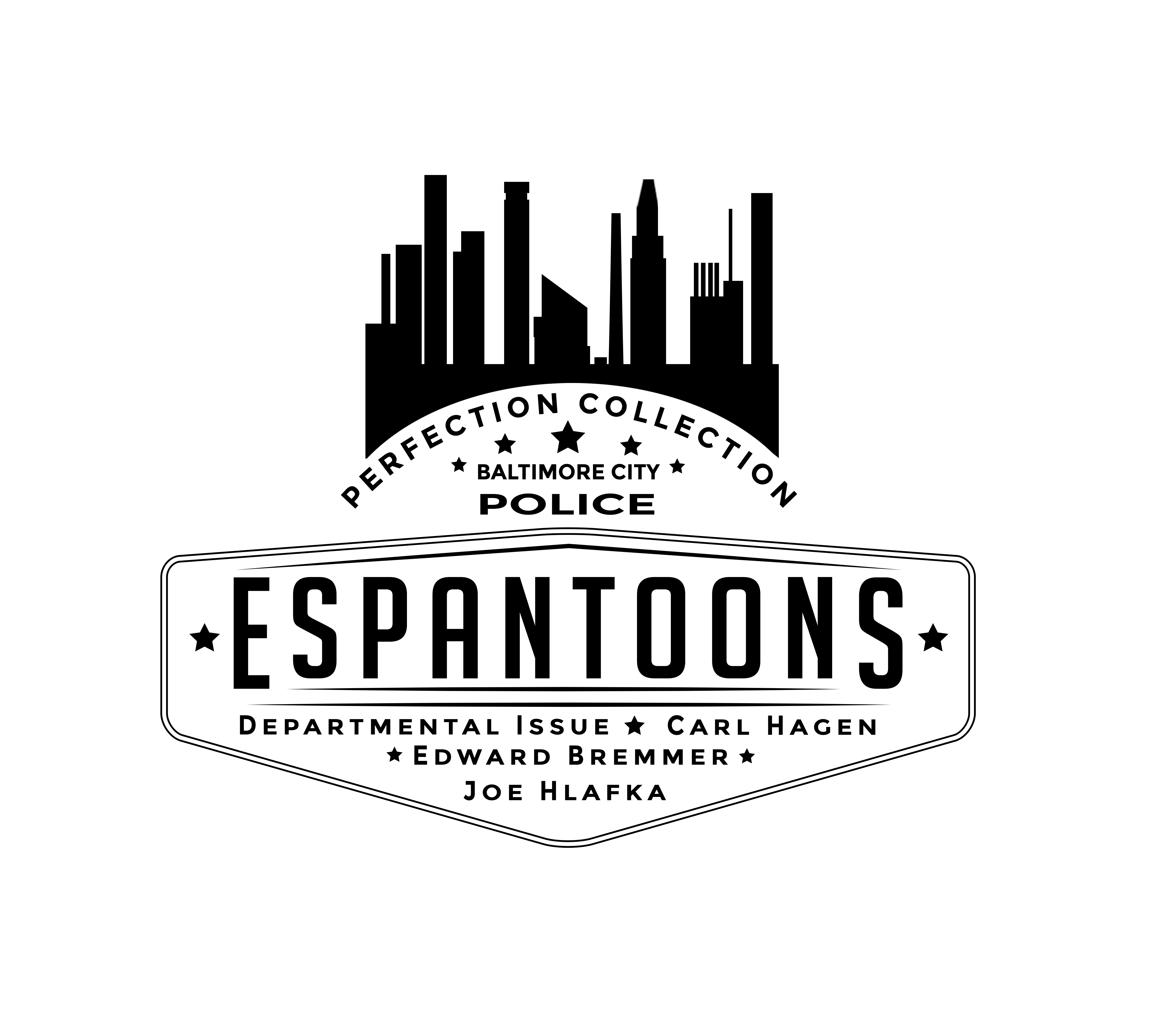
The Perfection Collection was a well turned set of sticks turned to replicate four of Baltimore's most well known nightstick espantoon turners. Department Issued were turned by one of two Reverends, then three well known highly collectable stick makers Carl Hagen, Ed Bremmer and, Joseph "Nightstick Joe" Hlafka
Top Down - Department Issued Turned by Rev McKenney or Rev. Longenecker
Carl Hagen, Edward Bremmer, and Joseph "Nightstick Joe" Hlafka
![]()
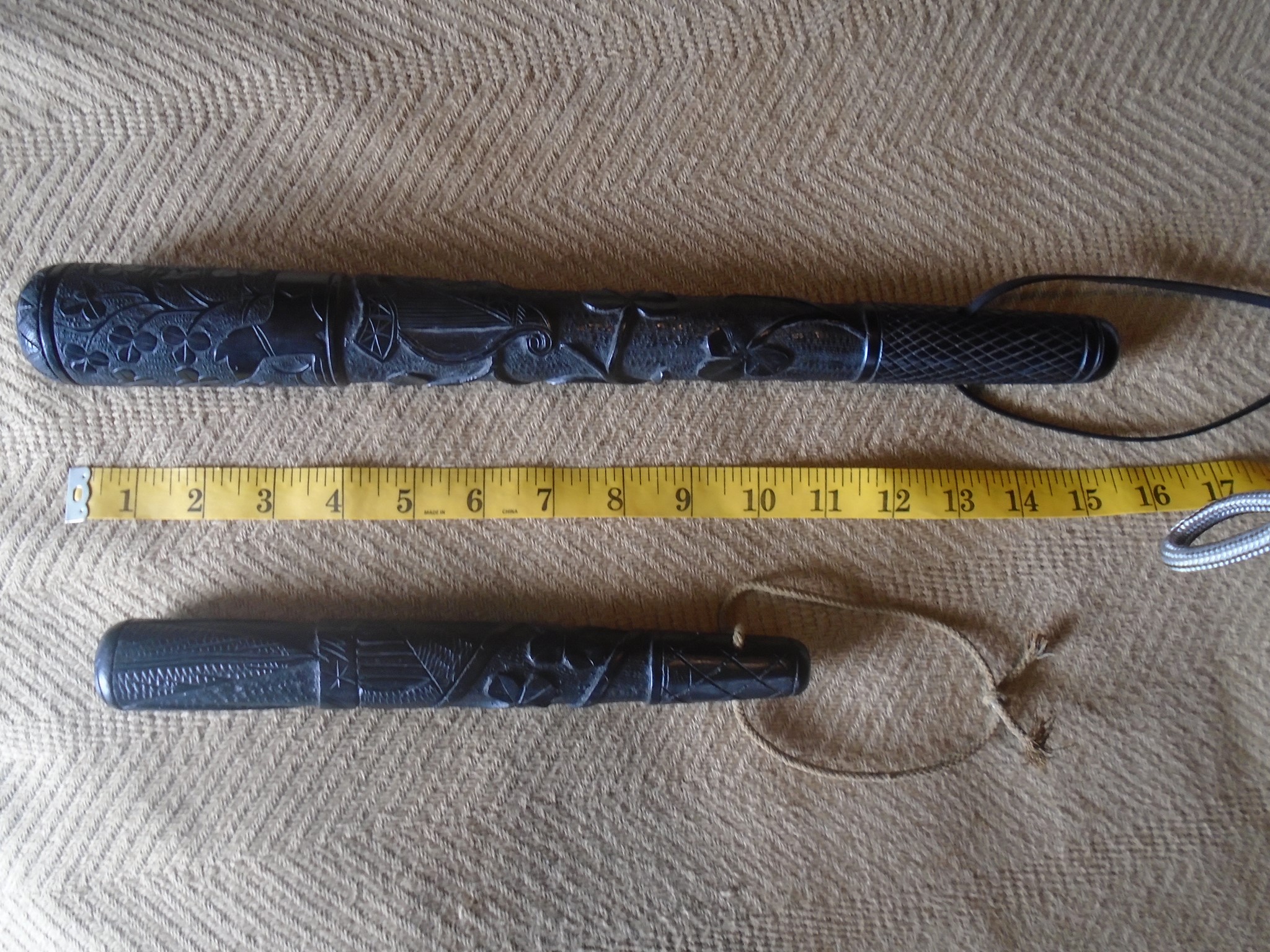
Courtesy Gary Provenzano
These are generally called "Bog Sticks". The story Gary shares is that when the Irish started taking over many of the jobs in American Police work in this country sometime around the turn of the Century, (1890/1910) they didn't care for the nightsticks being used at the time. So, they wrote back home to Ireland and asked to have bog wood sent to them. Bog wood is basically a petrified wood. It's an oak that had turned to stone after many years submerged in the bogs of Ireland. The wood is almost indestructible. If you were one of the, "favored sons," craftsmen in Ireland would carve the sticks with images from home, like shamrocks, dogs, cairns, etc. These sticks, usually from the New York City area are pretty rare and true works of art. The 2 shown have been in Gary Provenzano's collection for many years.
![]()
That's it for Now But with the number of sticks being sent in as gifts and those I buy, this will be continued for sure. Thanks for looking
Handcuffs and Restraints
![]()
POLICE INFORMATION
If you have copies of: your Baltimore Police Department Class Photo, Pictures of our Officers, Vehicles, Equipment, Newspaper Articles relating to our department and or officers, Old Departmental Newsletters, Lookouts, Wanted Posters, and or Brochures. Information on Deceased Officers and anything that may help Preserve the History and Proud Traditions of this agency. Please contact Retired Detective Kenny Driscoll.

NOTICE
How to Dispose of Old Police Items
Please contact Det. Ret. Kenny Driscoll if you have any pictures of you or your family members and wish them remembered here on this tribute site to Honor the fine men and women who have served with Honor and Distinction at the Baltimore Police Department. Anyone with information, photographs, memorabilia, or other "Baltimore City Police" items can contact Ret. Det. Kenny Driscoll at
Copyright © 2002 Baltimore City Police History - Ret Det Kenny Driscoll
